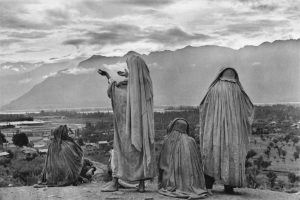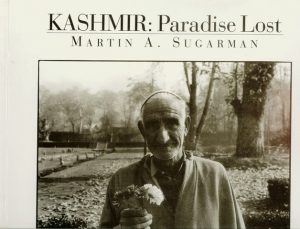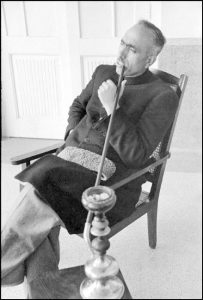Peace Watch » Kashmir-Talk » Pictures Speak speak louder than word- Our photojournalist have a role
Pictures Speak speak louder than word- Our photojournalist have a role
Punchline
Pictures Speak
Such Silence Is Louder Than Words
By
-
Z. G. Muhammad
Photos tell a story- a forceful story that even a hundred page book on history can barely tell.  Some photographs live up to proverbial million dollar stories. Some days back, a French photographer, Henri Cartier-Bresson, historic picture clicked in 1948 at iconic small plateau Kastur-Pend atop the Koh-i-Maran hillock was sold at an auction in New York at 32,500 dollars. This perhaps is the first picture of Kashmir that has fetched such a big price at Philips Auction House, in New York.
Some photographs live up to proverbial million dollar stories. Some days back, a French photographer, Henri Cartier-Bresson, historic picture clicked in 1948 at iconic small plateau Kastur-Pend atop the Koh-i-Maran hillock was sold at an auction in New York at 32,500 dollars. This perhaps is the first picture of Kashmir that has fetched such a big price at Philips Auction House, in New York.  The seventy-year-old picture of Kashmiri women in traditional costumes facing Dargah Hazratbal seeking the blessings of Allah atop the hillock facing towards the Hazratbal Shrine does not only provide an insight into the socio-cultural ethos of the times but also tells a big story about the turbulent times that had plunged people into yet another phase of uncertainty. In this column, some years back, I had written in detail about the importance of this picture to the cultural history of the land.
The seventy-year-old picture of Kashmiri women in traditional costumes facing Dargah Hazratbal seeking the blessings of Allah atop the hillock facing towards the Hazratbal Shrine does not only provide an insight into the socio-cultural ethos of the times but also tells a big story about the turbulent times that had plunged people into yet another phase of uncertainty. In this column, some years back, I had written in detail about the importance of this picture to the cultural history of the land.
Cartier-Bresson, seen as ‘humanist photographer’ has captured historic moments of Indian history after Independence that perhaps no other photographer has done. He had photographed Gandhi hours before his assassination. His extensive pictures of refugee camps speak a million word about ‘massive sociopolitical crisis in India and Pakistan’s shared history.’ Other than the photograph that fetched good money at the auction, his many photos on Kashmir, including one of Sheikh Abdullah Prime Minister of the State (1948)
enjoying a hookah at Jammu also tell thousands of words stories.
Kashmir, for its scenic beauty since an early twentieth century, has been an attraction for European photographers and occasional clicks of human interest by them that have found a place in some travelogue do tell poignant stories about brutalities like corvee and whipping of peasants by the agents of the feudal lords. True, such pictures do tell a story but they don’t tell the whole truth. It is the photojournalist as rightly said by a leading American photojournalist Mark M. Hancock, who “is a visual reporter of facts.” In raising issues about the human rights and sufferings of the people in conflict areas and disputed territories photojournalist have been doing a commendable job. Sending shivers down the spine of general public some photos do mobilize their opinion- in our case 13 July 1931 carnage outside the Srinagar central jail is a classic example. The ghoulish scene captured by Ghulam Mohi-u-Din Rahabar- our first photojournalist published in Urdu press of British Punjab had shaken an important section of the society and caused a movement in support of the overwhelming majority of the state and against the feudal-autocracy. These pictures, almost ninety years after speaks loudly about the bloodbath- and the macabre that was enacted on the foothills of the Fort. The pictures of innocent Kashmiris sitting by the sides of the wooden charpais of martyrs on the lawns the Jamia Masjid with angst distinctly visible in their sparkling eyes tell even today the thousand-word stories. But for these pictures, we would have no visual records of 13 July 1931.
Minus some pictures by Henri Cartier-Bresson, we do not see any ‘magnum opus photos’ about the situation obtaining in the state after August 1947. Except, some international photojournalists on tourist visas occasionally visiting the state, Srinagar till 1990 ceased to a beat for important photojournalists. Some internationally known photojournalist in nineties did visit Kashmir but largely it was the local photojournalists risking their lives who reported for the international press. Despite, a good number of pictures clicked by them having the potential of becoming ‘pictures of all time’ these have been as good as lost- for none of them brought them out in the form of a book. Lots of pictures tell the whole truth that thousands of words cannot say. Nonetheless, some reputed international photojournalists have produced some photo-books.
‘The camera doesn’t lie, it just tells a story’. True to this saying every picture in these books tells a story truthfully as it happened. At the turn of the century, perhaps in 2002, ‘the Heart of Kashmir’ a photo-book by  an Italian photojournalist, Kash Gabriele Torstellio was published by Kash GT, London. A decade and a half later it hit stands in Srinagar. Toresetellio was in India as a journalist and had traveled from Kerala on a train to Jammu- then to Srinagar. In his brief text to this collage of over ninety black and white photographs photojournalist vividly tells how common Indian on the train during his five days and four nights travel felt about the Kashmir situation. The most common refrain was: ‘it is a dangerous place’ don’t go there’. The book starts with a pitch-black photograph of funeral prayer. There are lots of pictures about robust soldiers in full battledress and playful children on the deserted streets. Almost every photograph has a thousand word story to tell. In this column, it is not possible to comment on every photograph contained in the book.
an Italian photojournalist, Kash Gabriele Torstellio was published by Kash GT, London. A decade and a half later it hit stands in Srinagar. Toresetellio was in India as a journalist and had traveled from Kerala on a train to Jammu- then to Srinagar. In his brief text to this collage of over ninety black and white photographs photojournalist vividly tells how common Indian on the train during his five days and four nights travel felt about the Kashmir situation. The most common refrain was: ‘it is a dangerous place’ don’t go there’. The book starts with a pitch-black photograph of funeral prayer. There are lots of pictures about robust soldiers in full battledress and playful children on the deserted streets. Almost every photograph has a thousand word story to tell. In this column, it is not possible to comment on every photograph contained in the book.
Martin R. Sugarman is another big name in the world of international journalism. In the recent past, there has been hardly a major conflict or dispute that he has not captured on his camera. Besides India and Pakistan, he has covered Bosnia, Cuba, Mexico, the Middle East Chechnya, Tibet, Afghanistan, East Timor, Guatemala and Nagorna Karabakh. In 1993, Sugarman visited Jammu and Kashmir on both the sides of  dividing line. The 137-page book, containing over hundred photographs in black and white captures the situation on both the sides of the LOC. Every picture in the book tells a whole-truth. It had then received many reviews at the international level and had also caused ripples in diplomatic circles. ‘War Above The Clouds: Siachen Glacier’ is another important photo-book by the California born American photojournalist on Jammu and Kashmir. ‘His book has become a standard on the subject’.
dividing line. The 137-page book, containing over hundred photographs in black and white captures the situation on both the sides of the LOC. Every picture in the book tells a whole-truth. It had then received many reviews at the international level and had also caused ripples in diplomatic circles. ‘War Above The Clouds: Siachen Glacier’ is another important photo-book by the California born American photojournalist on Jammu and Kashmir. ‘His book has become a standard on the subject’.
Some Srinagar based photographers have published some very good photo-books for marketing Kashmir internationally as a tourist destination. Nonetheless, our photo-journalists who have captured the state in all its colors and shades since the seventies are yet to publish a photo-book. Let them leave something behind for the posterity.
Published in Greater Kashmir on 25-12-2017
Note: I have not seen “witness” compiled by Sanjay Kak featuring pix of nine photojournalists – so have not written about this collage.
See Video
Filed under: Kashmir-Talk








